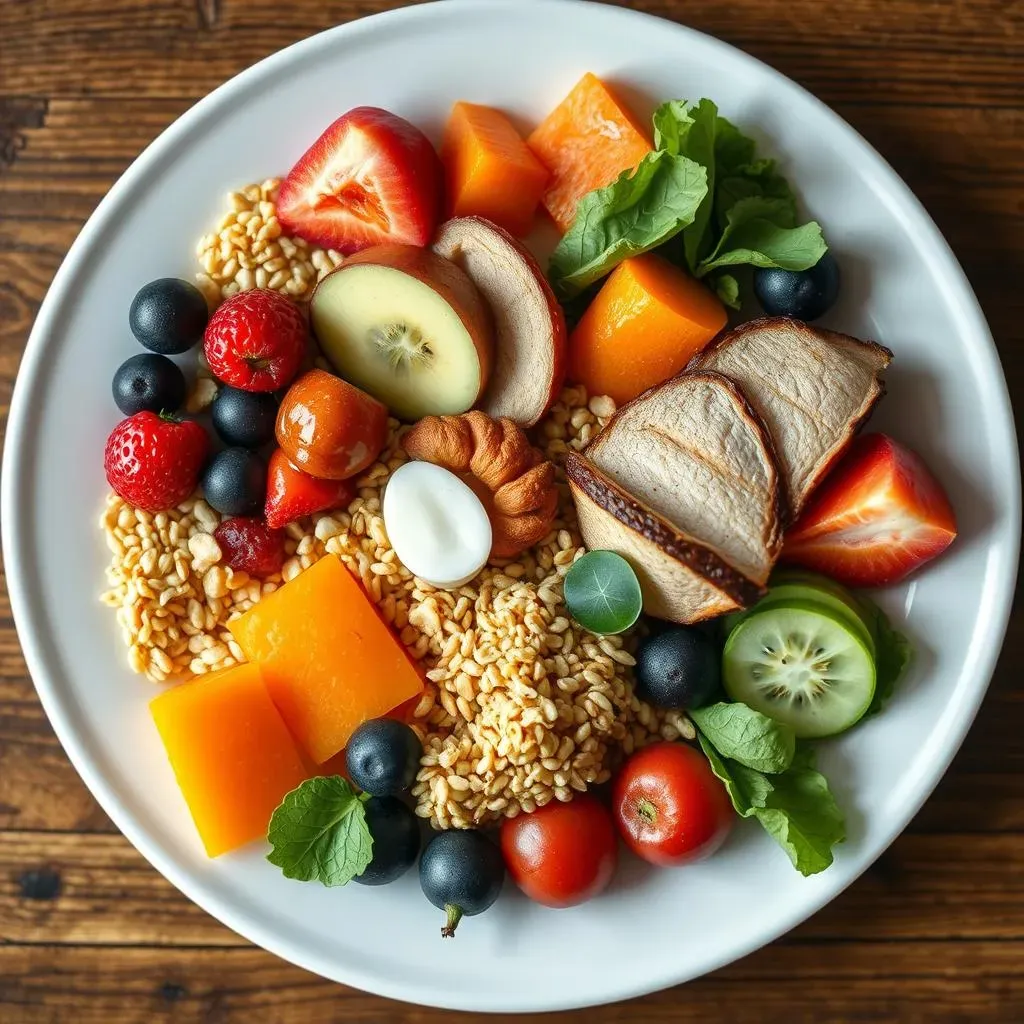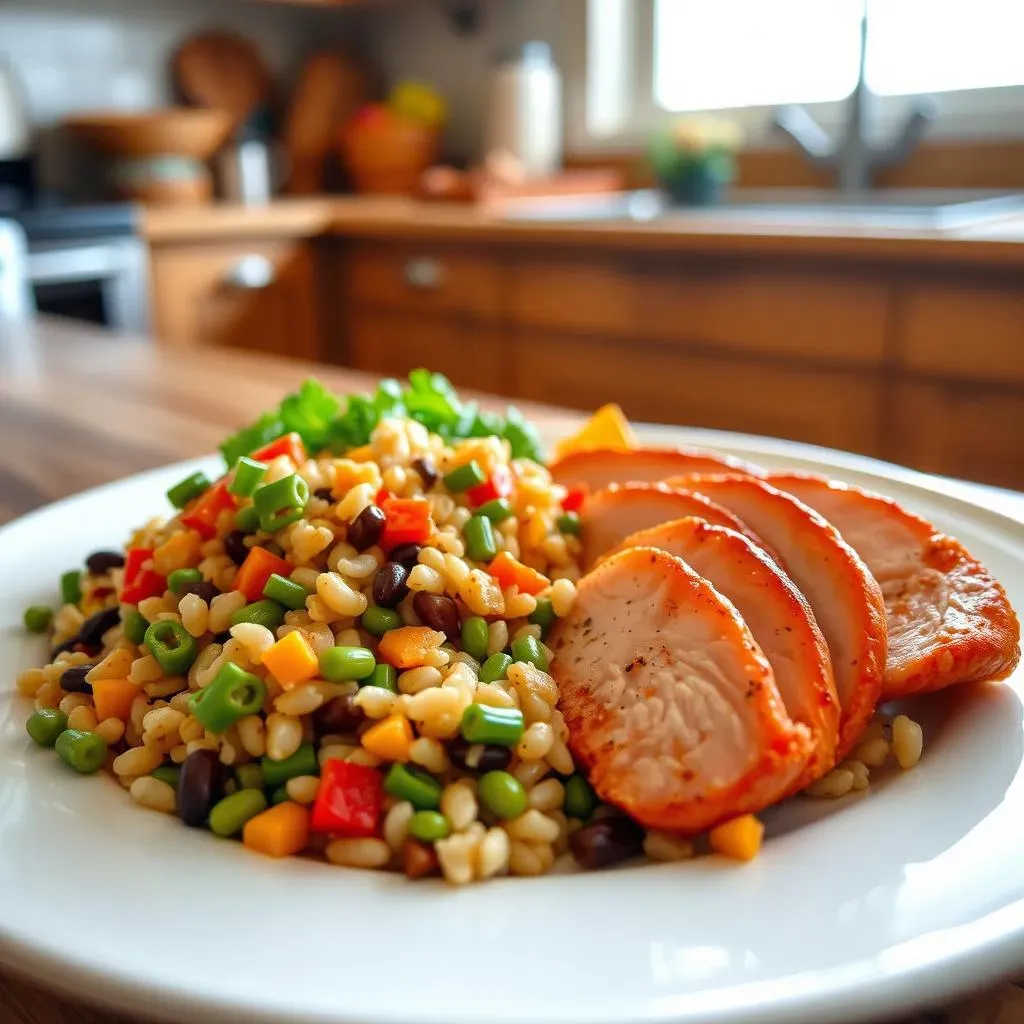Table of Contents
Ever stared at your plate wondering if you're eating right? You're not alone. Figuring out what does a healthy dinner plate look like can feel like a puzzle. We're bombarded with so much advice, it's easy to get lost in the noise. Forget complicated diets and strict rules. This article cuts through the confusion, giving you a simple, visual guide to building balanced, satisfying meals. We'll explore the power of plants, how to choose the right grains and proteins, and why it all matters for your health. Think of this as your roadmap to a happier, healthier you, one plate at a time. Ready to ditch the diet drama and embrace real food? Let's get started.
Building a Balanced Plate: What Does a Healthy Dinner Plate Look Like?

Building a Balanced Plate: What Does a Healthy Dinner Plate Look Like?
The Plate Method: A Simple Start
Okay, so you're probably wondering, "What's the big deal with a plate?" It's not about fancy dishes or portion control freak-outs. It's about visualizing the right amount of each food group. Think of your plate as a pie chart. Half of it should be loaded with colorful fruits and veggies. These are your vitamin and fiber powerhouses. They fill you up without weighing you down. The other half is split between whole grains and lean proteins. This method isn't a diet, it's a way to make sure you're getting everything your body needs.
Why This Plate Works
Following this plate method isn't just some random suggestion. It's based on solid science. It's about making sure you get a good mix of nutrients. This helps keep your energy levels stable, your digestion happy, and your body strong. It also helps to cut down on the unhealthy stuff that can lead to health problems down the road. We're not talking about deprivation here; it's about balance. It's about making the good stuff the star of the show, while still enjoying everything in moderation.
Plate Section | Food Group | Why It's Important |
|---|---|---|
Half the Plate | Fruits and Vegetables | Vitamins, minerals, fiber, antioxidants |
Quarter of the Plate | Whole Grains | Energy, fiber, nutrients |
Quarter of the Plate | Lean Protein | Muscle building, satiety, repair |
It's Not About Perfection, It's About Progress
Look, no one's expecting you to be a perfect plate-building machine overnight. The goal here is progress, not perfection. Some days, you might have a little more grains or protein, and that's okay. The key is to aim for that general balance most of the time. Don't get hung up on the details. Start with making small changes and see how you feel. It's about finding a way of eating that works for you, that's sustainable, and that makes you feel good.
The Power of Plants: Filling Half Your Plate

The Power of Plants: Filling Half Your Plate
The Colorful Crowd
Alright, let's talk about the fun part – veggies and fruits! Seriously, think of your plate as a canvas, and these are your vibrant paints. We're not talking about sad, steamed broccoli here. We're talking about a rainbow of colors: deep greens like spinach and kale, bright reds from tomatoes and bell peppers, oranges from carrots and sweet potatoes, and so much more. Each color brings its own set of vitamins, minerals, and antioxidants. These little guys are like the superheroes of nutrition, fighting off disease and keeping your body in tip-top shape. So, load up that half of your plate with as much variety as you can manage. The more, the merrier!
Beyond the Basics
Now, it's not just about tossing any old fruit or veggie on your plate. It’s about being a bit strategic. Think about textures and flavors. Want a crunch? Add some raw carrots or celery. Need something softer? Roasted veggies are your best friend. Don't be afraid to experiment! Try grilling bell peppers, adding a handful of berries to your salad, or blending a smoothie packed with spinach. The goal is to make eating healthy enjoyable and sustainable. When your food tastes good, you're way more likely to stick with it. So, get creative, have fun, and explore the wonderful world of plant-based goodness.
Color | Example Vegetables | Key Nutrients |
|---|---|---|
Green | Spinach, Kale, Broccoli | Vitamin K, Folate, Fiber |
Red | Tomatoes, Bell Peppers, Radishes | Vitamin C, Lycopene, Antioxidants |
Orange/Yellow | Carrots, Sweet Potatoes, Yellow Peppers | Vitamin A, Beta-carotene, Potassium |
Purple/Blue | Eggplant, Purple Cabbage, Blueberries | Antioxidants, Anthocyanins, Fiber |
Fueling Up Right: Grains and Protein on Your Healthy Dinner Plate

Fueling Up Right: Grains and Protein on Your Healthy Dinner Plate
The Good Grain Game
Okay, so we've got our veggies and fruits covered, now let's talk grains. But not just any grains, we're talking whole grains. Think brown rice, quinoa, whole wheat bread, and oats. These guys are way better than their refined cousins like white bread and pasta. Why? Because they're packed with fiber, which keeps you feeling full and helps your digestion. Plus, they give you sustained energy, so you don't get that afternoon slump. It’s like the difference between a slow-burning log in a fireplace and a quick burst of a match. One keeps you going, the other fades fast.
Protein Power
Next up, protein! This is essential for building and repairing tissues, keeping your muscles strong, and keeping you feeling satisfied. It's like the construction crew of your body, always working to keep everything in tip-top shape. We're not just talking about steaks and chicken here; there's a whole world of protein out there. Think lean meats, poultry, fish, eggs, beans, lentils, tofu, and even nuts and seeds. The key is to choose a variety of sources to get all the essential amino acids your body needs. This variety also makes your meals more exciting and keeps things from getting boring.
Protein Source | Why It's Great |
|---|---|
Lean Meats & Poultry | Excellent source of protein, iron, and B vitamins. |
Fish | Rich in protein and omega-3 fatty acids, good for heart health. |
Beans & Lentils | Plant-based protein, high in fiber, and affordable. |
Tofu & Tempeh | Plant-based protein, versatile for various dishes. |
Balancing Act
The trick is to get the right balance. Your grains and protein should each take up about a quarter of your plate. It's not about measuring exactly, but rather aiming for a visual balance. Some days, you might have a bit more protein, other days a bit more grains, and that’s totally fine. The key is to listen to your body and make sure you're getting a mix of both. It's like a good team, each part playing its role to help you perform at your best. So, don't be afraid to experiment and find what works best for you, your taste buds, and your body.
Beyond the Plate: Healthy Habits and Considerations

Beyond the Plate: Healthy Habits and Considerations
It's More Than Just Food
Alright, so you've got the plate thing down, but let's be real, a healthy lifestyle isn't just about what's on your plate. It's about the whole package. Think about things like how much water you're drinking, how much you're moving your body, and how well you're sleeping. These things all play a huge part in your overall well-being. It's like having a great car, but forgetting to fill it with gas or check the tires. You need to take care of all the parts to keep things running smoothly. And let's not forget the importance of stress management. Stress can wreak havoc on your body and your food choices. It's like trying to bake a cake in a hurricane - it's just not going to turn out well.
Hydration, Movement, and Sleep
Let's break it down a bit, shall we? Water is your body’s best friend, crucial for everything from digestion to energy levels. Think of it as the oil that keeps your engine running smoothly. Aim for at least eight glasses a day and adjust based on your activity levels. Movement is also key. You don't need to become a marathon runner overnight, but try to get some physical activity every day. It could be a brisk walk, a bike ride, or even a dance party in your living room. Find something you enjoy and make it a habit. And sleep? Oh, sleep. It's like the reset button for your body and mind. Aim for 7-9 hours of quality sleep each night. Your body will thank you for it. It's like giving your phone a full charge after a long day - you'll feel refreshed and ready to go.
Mindful Eating and Listening to Your Body
Finally, let's talk about mindful eating. This is about paying attention to your body's cues and eating when you're truly hungry, not just because you're bored or stressed. It's about slowing down, savoring your food, and enjoying the experience. It's like appreciating the art in a painting, rather than just glancing at it. Put away the distractions, take a few deep breaths before you eat, and really notice the flavors and textures of your food. And most importantly, listen to your body. It's pretty good at telling you what it needs. If you're full, stop eating. If you're craving a particular food, it might be a sign that your body needs certain nutrients. It's about building a healthy relationship with food, one that's based on respect, enjoyment, and understanding.
Small Changes, Big Impact
Remember, it's not about doing everything perfectly all the time. It's about making small, sustainable changes that you can stick with. Maybe start by adding an extra serving of veggies to your dinner each night or swapping out sugary drinks for water. Small changes add up over time. It's like saving a little money each day - it might not seem like much at first, but it can turn into something significant over time. Be patient with yourself, celebrate your progress, and don't be afraid to ask for help when you need it. You've got this!
Healthy Habit | Why It Matters |
|---|---|
Hydration | Supports bodily functions, boosts energy, aids digestion. |
Regular Movement | Improves cardiovascular health, strengthens muscles, enhances mood. |
Quality Sleep | Essential for physical and mental restoration, supports immune function. |
Mindful Eating | Promotes a healthy relationship with food, prevents overeating, enhances enjoyment. |
Wrapping Up: Your Path to a Healthier Plate
So, what does a healthy dinner plate look like? It's not about perfection, it's about balance. By filling half your plate with colorful veggies and fruits, choosing whole grains, and adding lean protein, you’re setting yourself up for success. It's about making choices that nourish your body and make you feel good. Remember, this isn't a rigid rulebook, it's a flexible guide to help you create meals you love and that love you back. Small changes can lead to big improvements in your health and well-being. So, go ahead, build that awesome plate and enjoy!